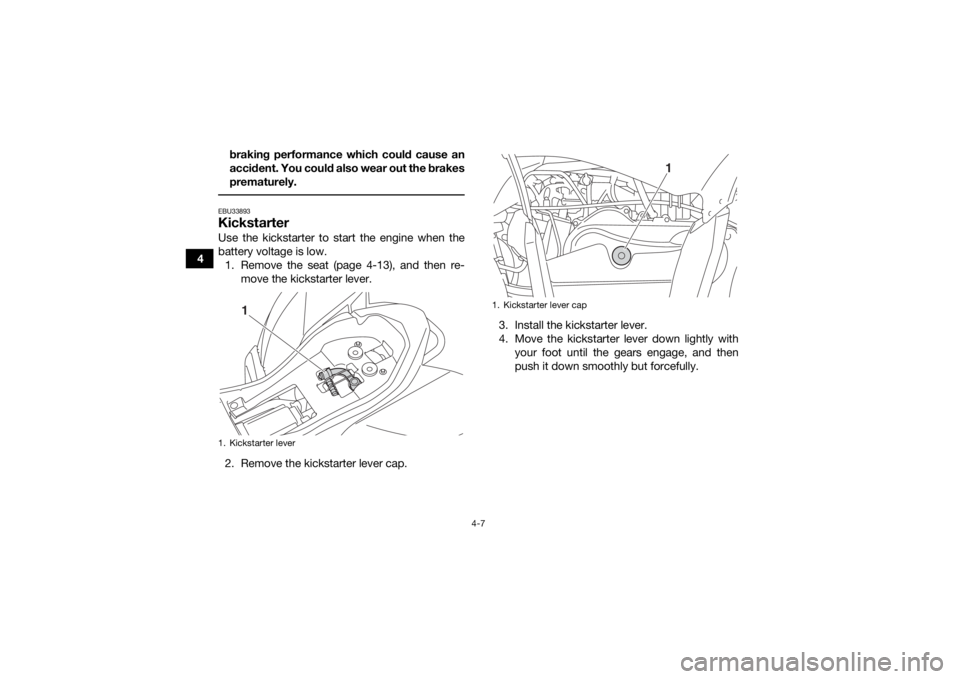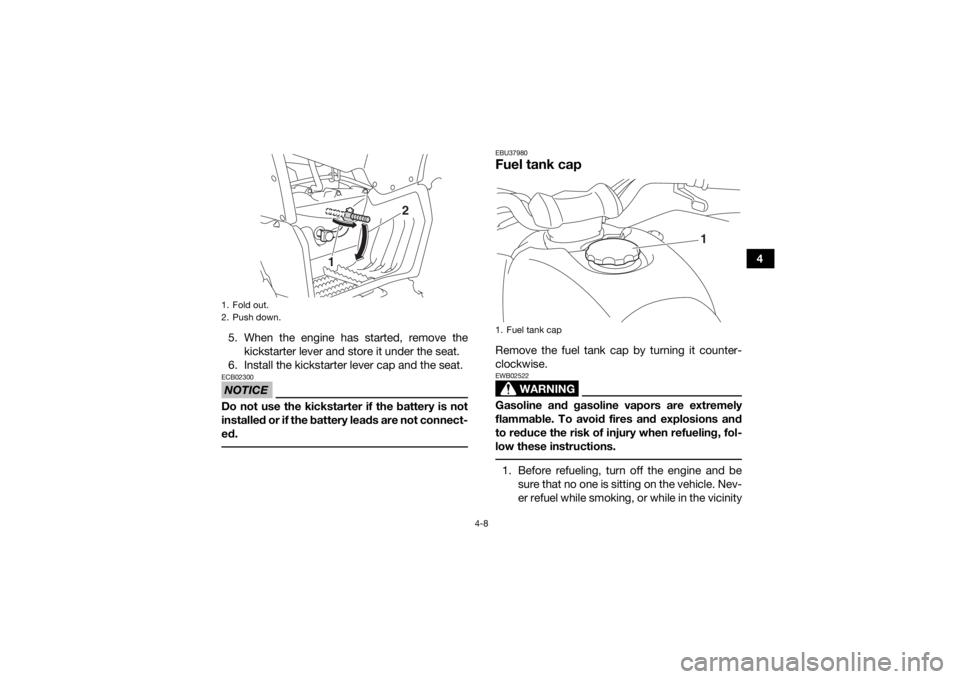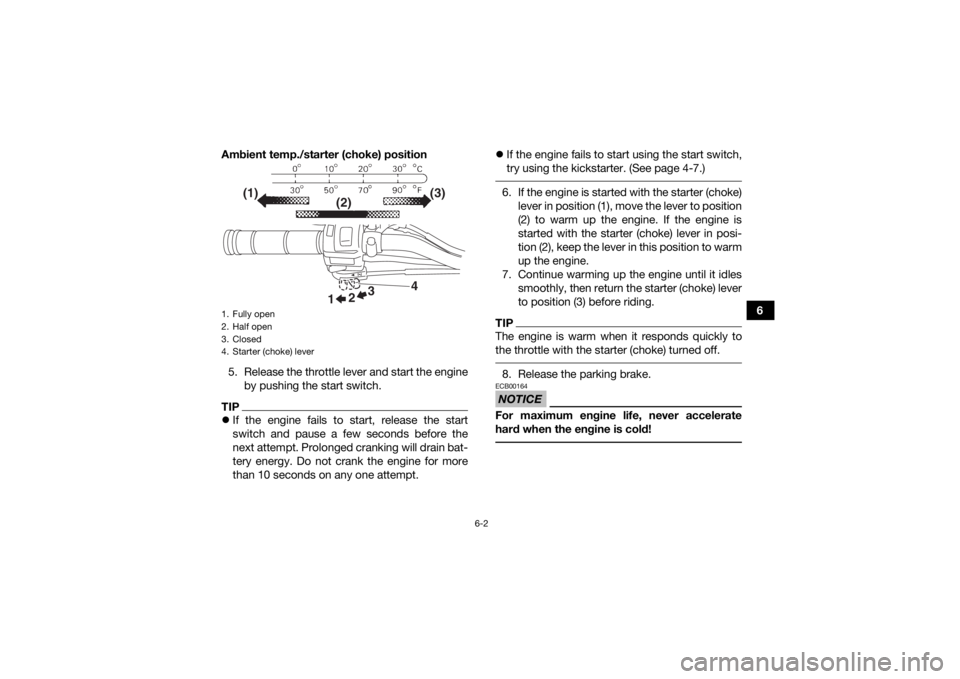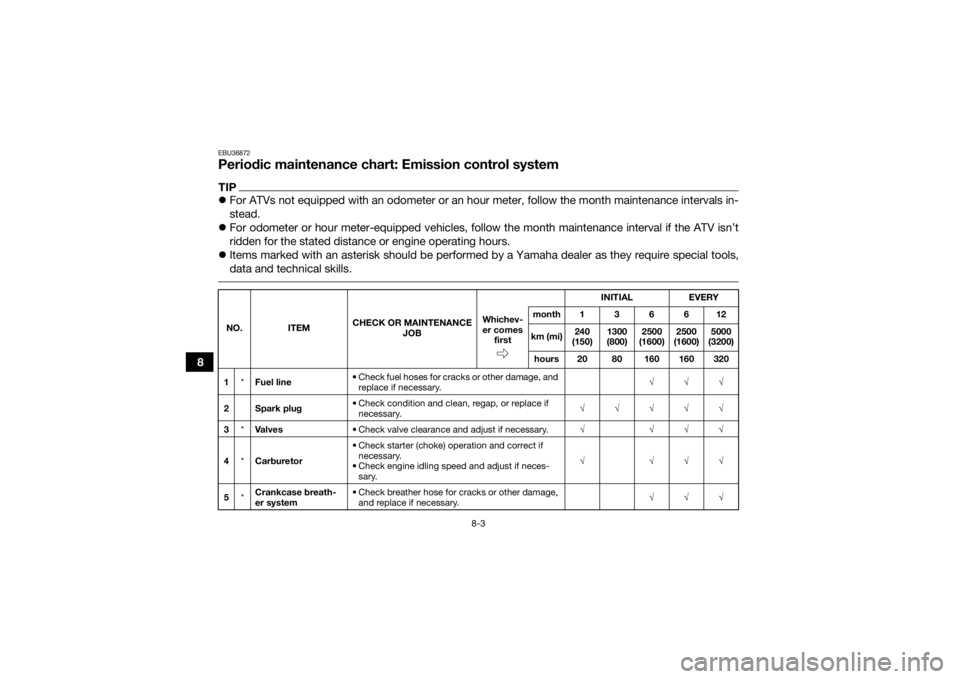Starter YAMAHA YFZ50 2020 Owners Manual
[x] Cancel search | Manufacturer: YAMAHA, Model Year: 2020, Model line: YFZ50, Model: YAMAHA YFZ50 2020Pages: 126, PDF Size: 5.44 MB
Page 9 of 126

EBU17421
TABLE OF CONTENTS
LOCATION OF THE WARNING AND
SPECIFICATION LABELS .............................. 1-1
SAFETY INFORMATION ................................ 2-1
DESCRIPTION................................................ 3-1Left view ...................................................... 3-1
Right view.................................................... 3-1
Controls and instruments............................ 3-2
INSTRUMENT AND CONTROL
FUNCTIONS ................................................... 4-1 Main switch ................................................. 4-1
Handlebar switches .................................... 4-1
Engine stop switch with lanyard ................. 4-2
Throttle lever ............................................... 4-3
Speed limiter ............................................... 4-3
Front brake lever ......................................... 4-5
Rear brake lever .......................................... 4-6
Parking brake .............................................. 4-6
Kickstarter ................................................... 4-7
Fuel tank cap .............................................. 4-8
Fuel ............................................................. 4-9
Fuel cock................................................... 4-10 Starter (choke) ......................................... 4-12
Seat .......................................................... 4-13
Rear shock absorber ................................ 4-13
PRE-OPERATION CHECKS .......................... 5-1 Fuel ............................................................. 5-3
Engine oil .................................................... 5-3
Transmission oil .......................................... 5-3
Front and rear brakes ................................. 5-3
Throttle lever ............................................... 5-3
Drive chain .................................................. 5-3
Tires ............................................................ 5-3
Chassis fasteners ....................................... 5-6
Instruments and switches........................... 5-6
OPERATION .................................................. 6-1 Starting a cold engine................................. 6-1
Starting a warm engine............................... 6-3
Engine break-in........................................... 6-3
Parking........................................................ 6-3
Parking on a slope ...................................... 6-4
Accessories and loading ............................ 6-5UBW463E0.book Page 1 Monday, January 28, 2019 10:22 AM
Page 26 of 126

3-1
3
EBU17681
DESCRIPTION
EBU17691Left view
EBU17701Right view
1. Fuel tank cap
2. Fuel cock
3. Air filter
4. Engine stop switch with cord (lanyard)
5. Rear shock absorber
6. Kickstarter lever cap
7. Throttle stop screw
12
4
5
3
6
7
1. Spark arrester
2. Reflector
3. Tool kit
4. Fuse
5. Battery
6. Spark plug
7. Engine oil filler cap
8. Transmission oil filler cap1
23
4,5
6
78
UBW463E0.book Page 1 Monday, January 28, 2019 10:22 AM
Page 27 of 126

3-2
3
EBU17715Controls and instruments1. Rear brake lever
2. Handlebar switches
3. Parking brake lock plate
4. Front brake lever
5. Throttle lever
6. Main switch
7. Starter (choke) lever
12376 54
UBW463E0.book Page 2 Monday, January 28, 2019 10:22 AM
Page 34 of 126

4-7
4braking performance which could cause an
accident. You could also wear out the brakes
prematurely.
EBU33893KickstarterUse the kickstarter to start the engine when the
battery voltage is low.
1. Remove the seat (page 4-13), and then re- move the kickstarter lever.
2. Remove the kickstarter lever cap. 3. Install the kickstarter lever.
4. Move the kickstarter lever down lightly with
your foot until the gears engage, and then
push it down smoothly but forcefully.1. Kickstarter lever
1
1. Kickstarter lever cap
1
UBW463E0.book Page 7 Monday, January 28, 2019 10:22 AM
Page 35 of 126

4-8
4
5. When the engine has started, remove the kickstarter lever and store it under the seat.
6. Install the kickstarter lever cap and the seat.
NOTICEECB02300Do not use the kickstarter if the battery is not
installed or if the battery leads are not connect-
ed.
EBU37980Fuel tank capRemove the fuel tank cap by turning it counter-
clockwise.
WARNING
EWB02522Gasoline and gasoline vapors are extremely
flammable. To avoid fires and explosions and
to reduce the risk of injury when refueling, fol-
low these instructions. 1. Before refueling, turn off the engine and be sure that no one is sitting on the vehicle. Nev-
er refuel while smoking, or while in the vicinity
1. Fold out.
2. Push down.
1
2
1. Fuel tank cap
1
UBW463E0.book Page 8 Monday, January 28, 2019 10:22 AM
Page 39 of 126

4-12
4
RES
This indicates reserve. With the fuel cock lever in
this position, the fuel reserve is made available.
Turn the fuel cock lever to this position if you run
out of fuel while riding. When this occurs, refuel as
soon as possible and be sure to turn the fuel cock
lever back to “ON”!
EBU18852Starter (choke) “ ”Starting a cold engine requires a richer air-fuel
mixture. This mixture is controlled by the starter
(choke) system. To use the starter (choke) and enrich the air-fuel
ratio, move the starter (choke) lever in direction (a).
To decrease the starter (choke) or turn it off, move
the starter (choke) lever in direction (b).
TIPSee page 6-1 for engine starting instructions.
1. Arrow mark positioned over “RES”
1
1. Starter (choke) lever
1
(a) (b)
UBW463E0.book Page 12 Monday, January 28, 2019 10:22 AM
Page 48 of 126

6-1
6
EBU19882
OPERATION
EBU19902Read the Owner’s Manual carefully before riding
the ATV. If there is a control or function you do not
understand, ask your Yamaha dealer.
WARNING
EWB00632Read the Owner’s Manual carefully to become
familiar with all controls in order to help pre-
vent any loss of control, which could cause an
accident or injury. EBU36361Starting a cold engineNOTICEECB00151See the “Engine break-in” section on page 6-3
prior to operating the engine for the first time. 1. Set the parking brake. (The engine can bestarted only when the rear brake lever is ap-
plied.)
2. Turn the fuel cock to “ON”. 3. Turn the key to “ON” and set the engine stop
switch to “ ”.
4. Position the starter (choke) lever according to the ambient temperature.
Position (1):
Cold engine start with ambient temperature
below 5 °C (40 °F).
Position (2):
Cold engine start with ambient temperature
between 0 °C (30 °F) and 30 °C (90 °F).
Position (3):
Cold engine start with ambient temperature
above 25 °C (80 °F).
UBW463E0.book Page 1 Monday, January 28, 2019 10:22 AM
Page 49 of 126

6-2
6
Ambient temp./starter (choke) position
5. Release the throttle lever and start the engine by pushing the start switch.
TIPIf the engine fails to start, release the start
switch and pause a few seconds before the
next attempt. Prolonged cranking will drain bat-
tery energy. Do not crank the engine for more
than 10 seconds on any one attempt.
If the engine fails to start using the start switch,
try using the kickstarter. (See page 4-7.)
6. If the engine is started with the starter (choke)
lever in position (1), move the lever to position
(2) to warm up the engine. If the engine is
started with the starter (choke) lever in posi-
tion (2), keep the lever in this position to warm
up the engine.
7. Continue warming up the engine until it idles smoothly, then return the starter (choke) lever
to position (3) before riding.TIPThe engine is warm when it responds quickly to
the throttle with the starter (choke) turned off. 8. Release the parking brake.NOTICEECB00164For maximum engine life, never accelerate
hard when the engine is cold!
1. Fully open
2. Half open
3. Closed
4. Starter (choke) lever
4
3
2
1
(1) (3)
(2)
UBW463E0.book Page 2 Monday, January 28, 2019 10:22 AM
Page 50 of 126

6-3
6
EBU20292Starting a warm engineFollow the same procedure as for starting a cold
engine, with the exception that the starter (choke)
is not required when the engine is warm. Instead,
start the engine with the throttle slightly open.EBU36861Engine break-inThere is never a more important period in the life
of your engine than the first 240 km (150 mi) or 20
hours of operation. For this reason, you should fol-
low the engine break-in instructions carefully.
Since the engine is brand new, do not put an ex-
cessive load on it for the first 240 km (150 mi) or
20 hours. During this period the various parts in
the engine wear and polish themselves to the cor-
rect operating clearances. Avoid prolonged full-
throttle operation or any condition that might re-
sult in engine overheating.
0–120 km (0–75 mi) or 0–10 hours
Avoid prolonged operation above 1/2 throttle.
Vary the speed of the ATV regularly. Do not oper-
ate it at one set throttle position.120–240 km (75–150 mi) or 10–20 hours
Avoid prolonged operation above 3/4 throttle. Rev
the engine freely, but do not use full throttle at any
time.
240 km (150 mi) or 20 hours and beyond
The ATV can now be operated normally.
NOTICEECB00221If any engine trouble should occur during the
engine break-in period, immediately have a
Yamaha dealer check the ATV. EBU36370ParkingWhen parking the ATV, apply the rear brake lever,
stop the engine, apply the parking brake, and then
turn the fuel cock to “OFF”.
UBW463E0.book Page 3 Monday, January 28, 2019 10:22 AM
Page 78 of 126

8-3
8
EBU36872Periodic maintenance chart: Emission control systemTIPFor ATVs not equipped with an odometer or an hour meter, follow the month maintenance intervals in-
stead.
For odometer or hour meter-equipped vehicles, follow the month maintenance interval if the ATV isn’t
ridden for the stated distance or engine operating hours.
Items marked with an asterisk should be performed by a Yamaha dealer as they require special tools,
data and technical skills. NO. ITEM CHECK OR MAINTENANCE
JOB INITIAL
EVERY
Whichev-
er comes first month136612
km (mi) 240
(150) 1300
(800) 2500
(1600) 2500
(1600) 5000
(3200)
hours 20 80 160 160 320
1 *Fuel line • Check fuel hoses for cracks or other damage, and
replace if necessary. √√√
2 Spark plug • Check condition and clean, regap, or replace if
necessary. √√√√√
3 *Va l ve s • Check valve clearance and adjust if necessary. √ √√√
4 *Carburetor • Check starter (choke) operation and correct if
necessary.
• Check engine idling speed and adjust if neces- sary. √ √√√
5 *Crankcase breath-
er system • Check breather hose for cracks or other damage,
and replace if necessary. √√√
UBW463E0.book Page 3 Monday, January 28, 2019 10:22 AM